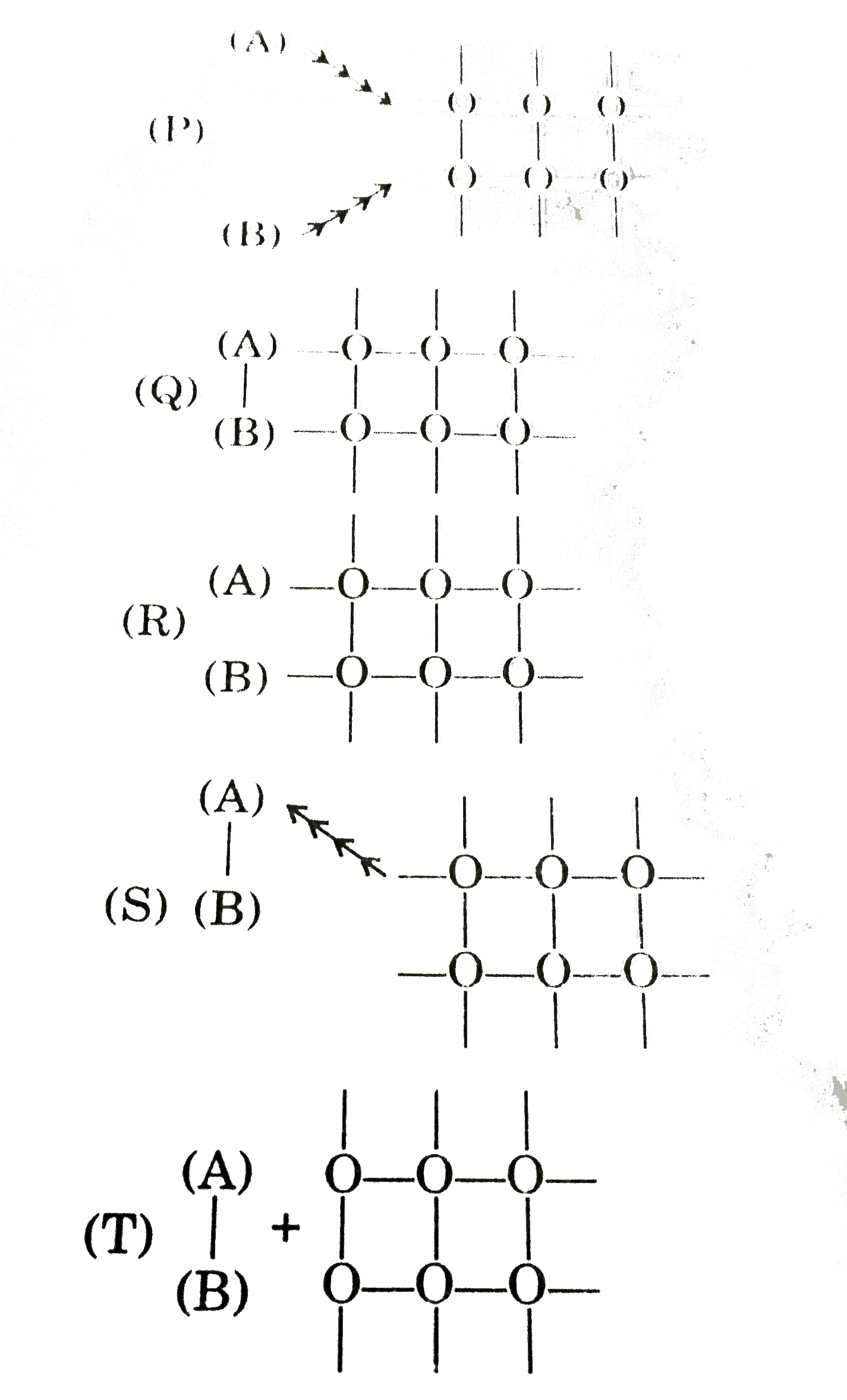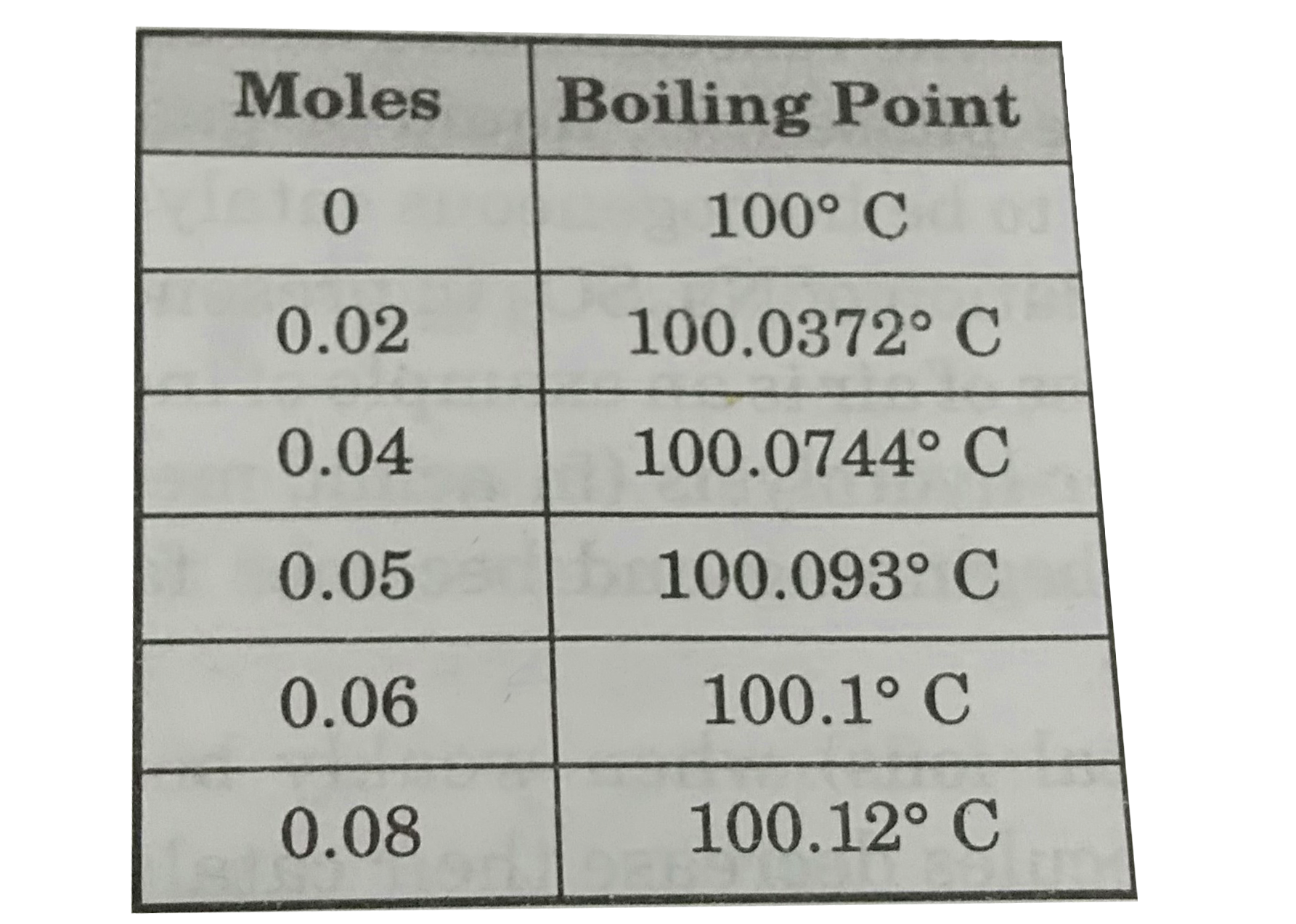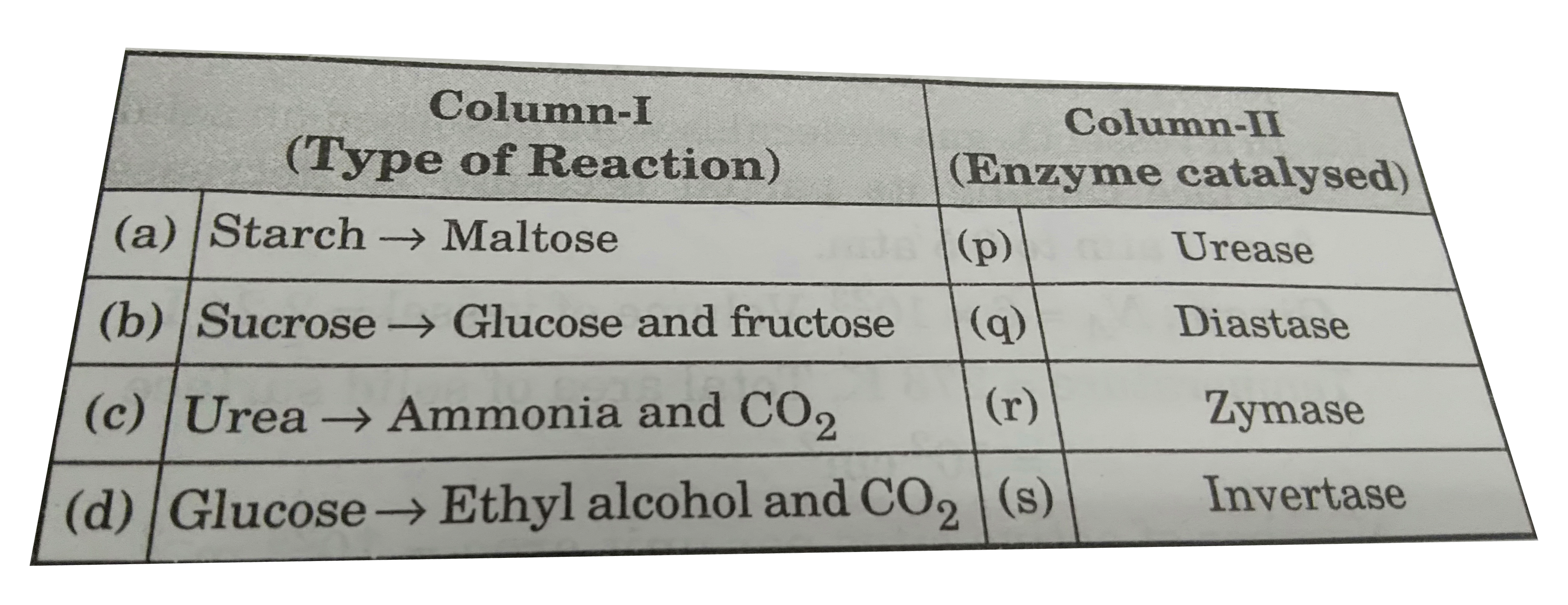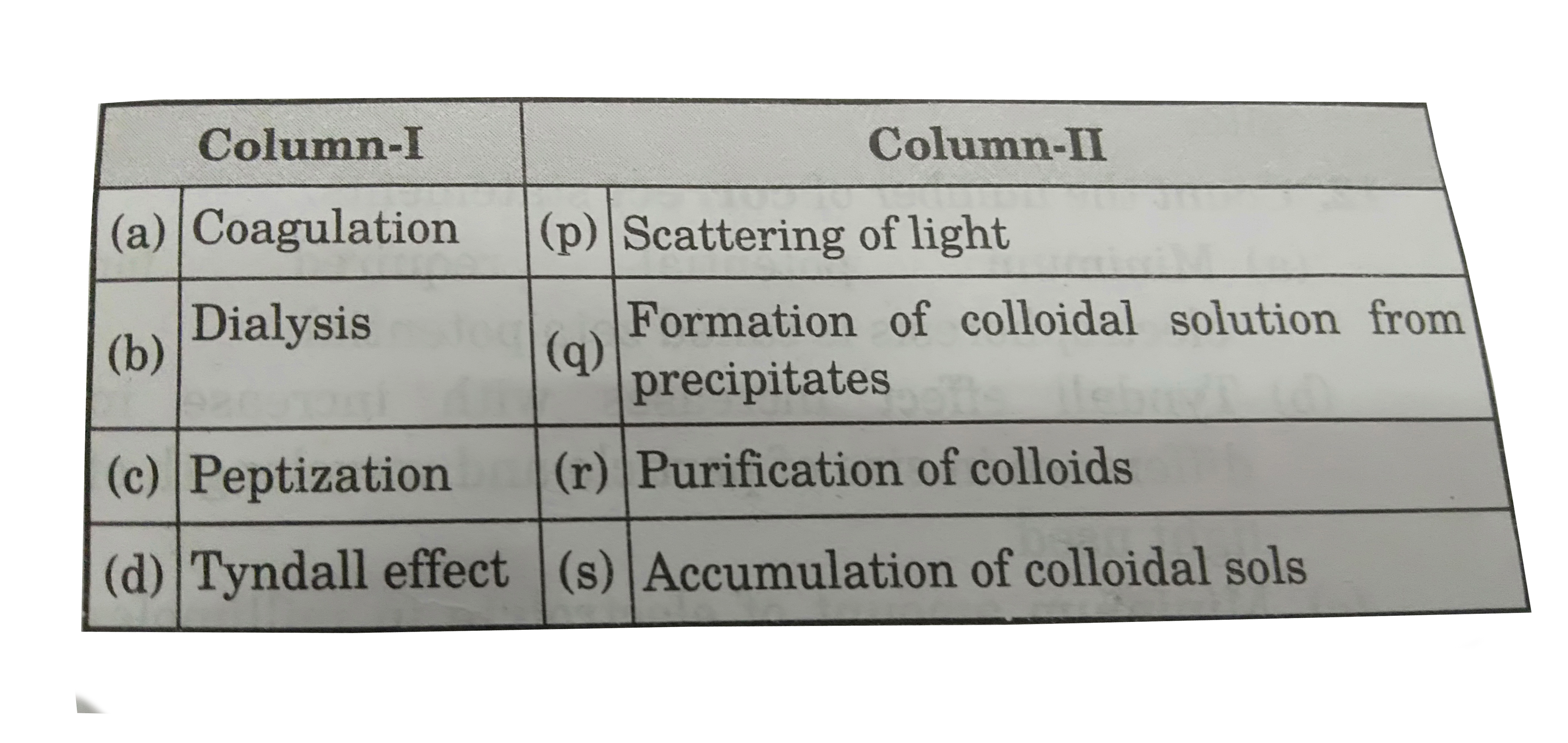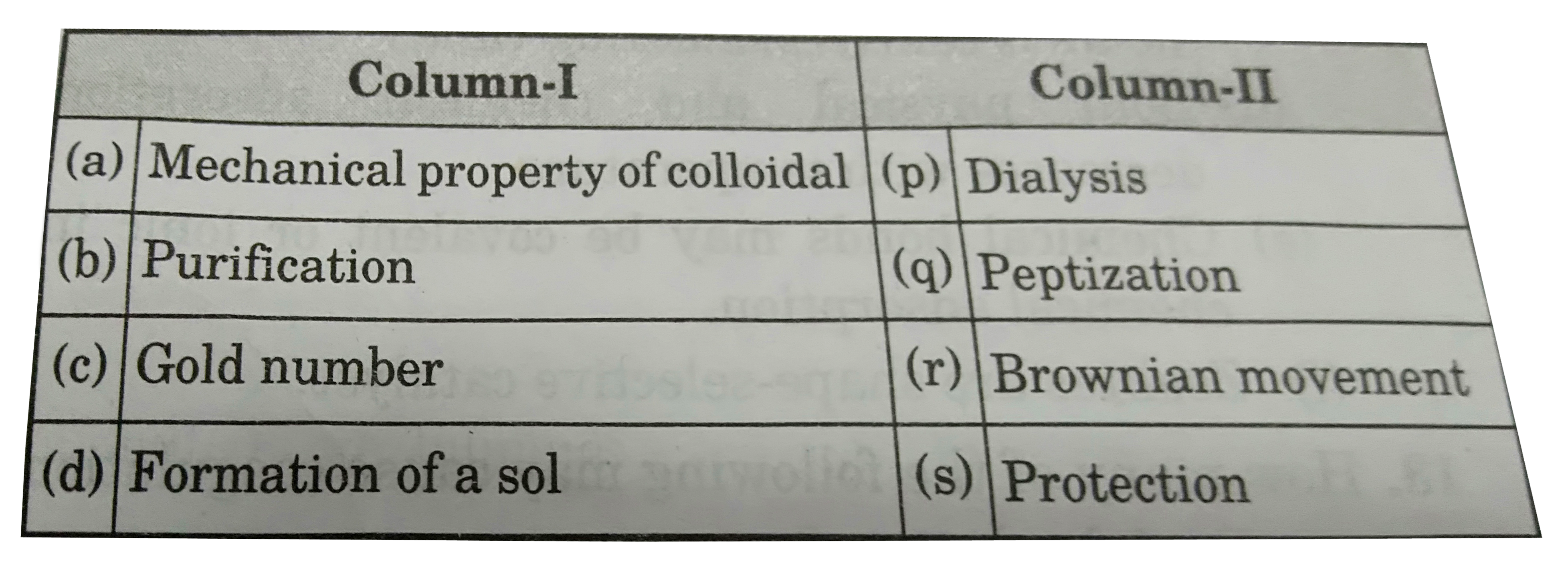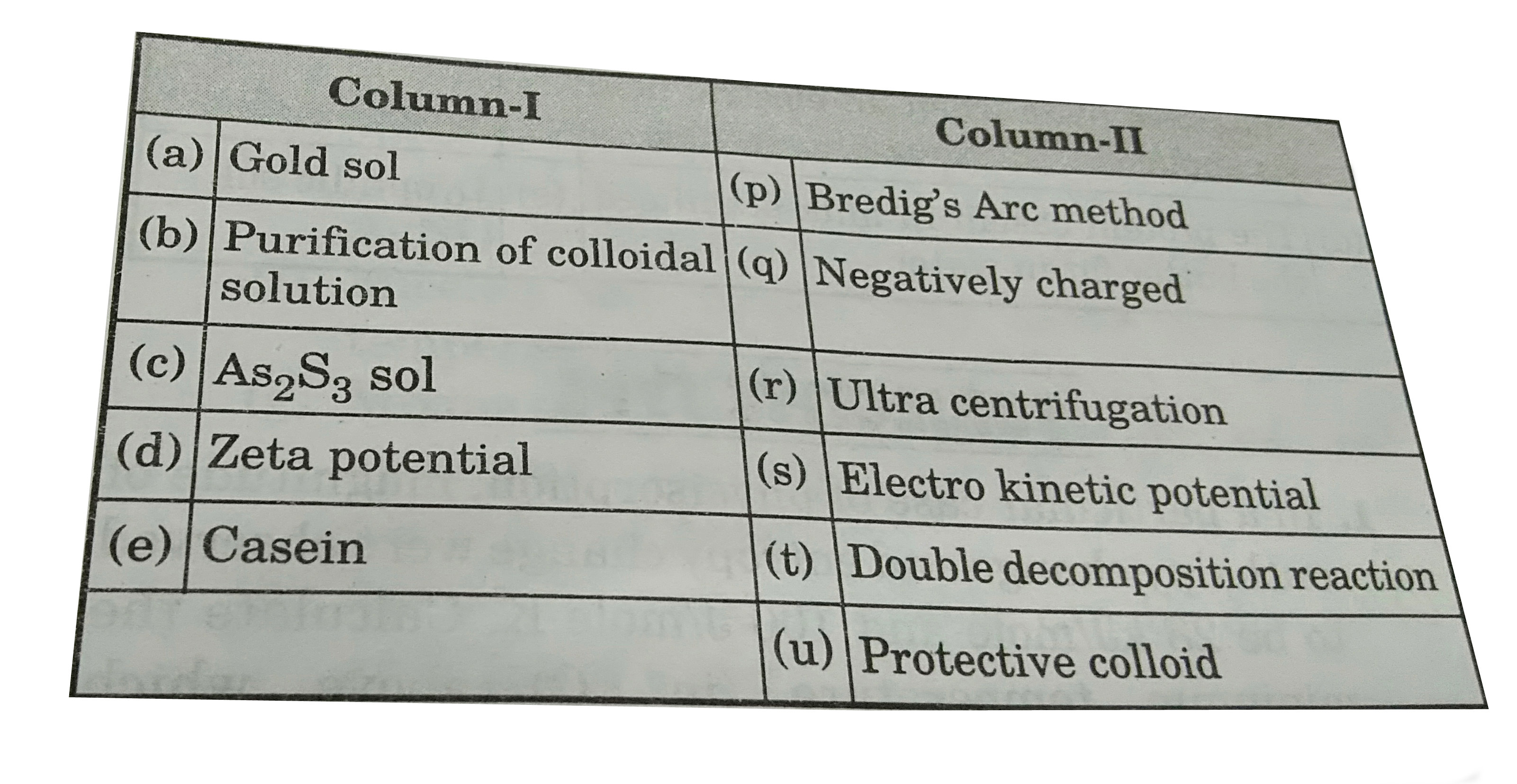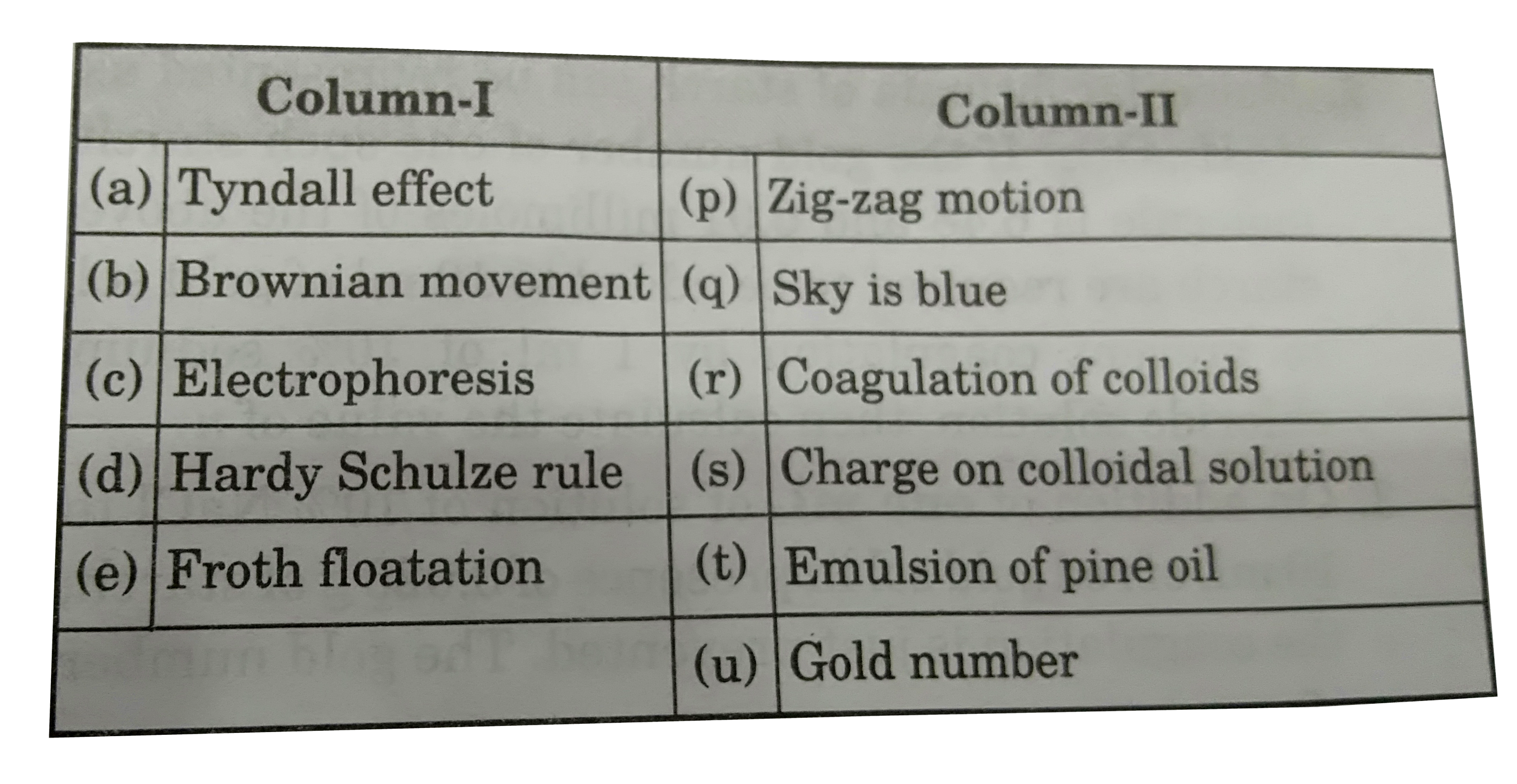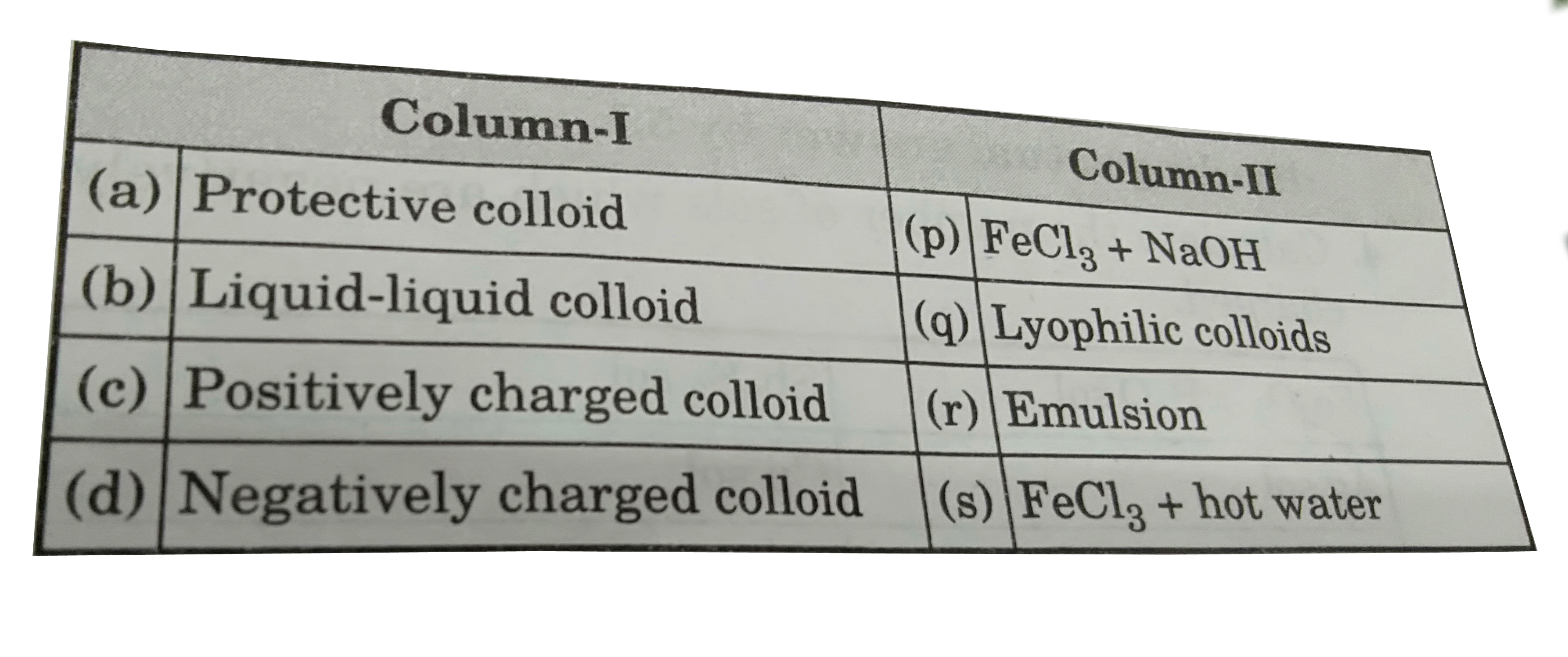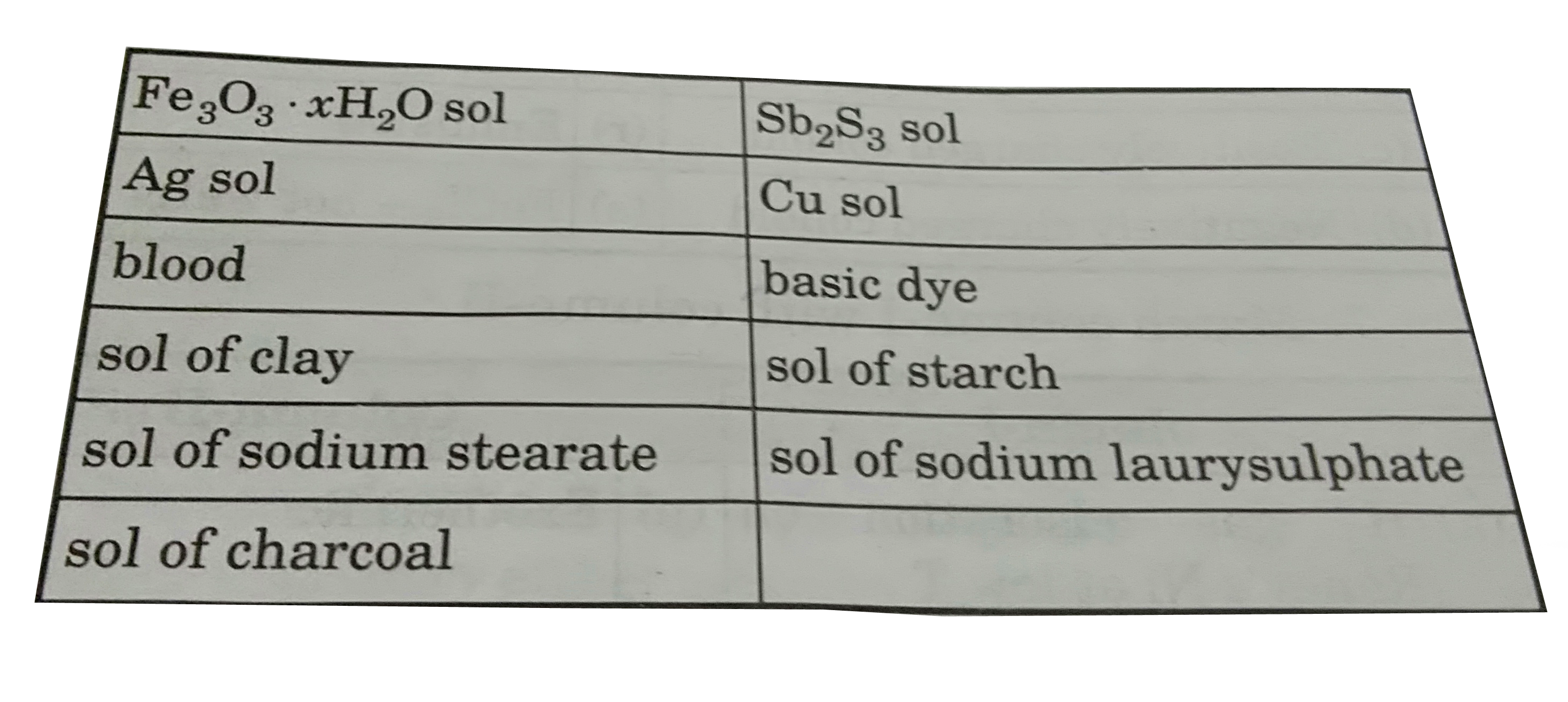D. Purification and Preparation of Colloid from GRB CHEMISTRY (HINGLISH) SURFACE CHEMISTRY for Class 12
| Class 12 | CHEMISTRY |
| Chapter | SURFACE CHEMISTRY |
| GRB CHEMISTRY (HINGLISH) | D. Purification and Preparation of Colloid |
| Medium | English |
| Academic Year | 2023-2024 |
Question 6
Finely divided catalyst has greater surface area and has greater catalytic activity than the compact solid. If a total surface area of 6291456 cm2 is required for adsorption in a catalytic gaseous reaction, then how many splits should be made in a cube of exactly 1 cm in length to achieve required surface area?
[Given : One split of a cube gives eight cubes of same size] View SolutionQuestion 34
Identify the option correctly representing True/False nature of the statements.
Statement-1: Changing the catalyst can change the final product obtained in some reaction.
Statement-2: Catalyst cannot change equilibrium constant of a reaction.
Statement-3: Lacto bacilli enzyme is responsible for curd formation from milk.
Statement-4: A promotor when taken without catalyst will always increase rate of reaction. View SolutionQuestion 125
(i) At 298 K the volume of NH3 adsorbed by 1 g of charcoal is higher than that of H2 under similar conditions.
(ii) The movement of colloidal particles towards the oppositely charged electrodes on passing current is known as Brownian movement.
If T for true and F for false then correct option is :View SolutionQuestion 137
Assertion: The Brownian movement is due to the bombardment on colloidal particle by the molecules of dispersion midium which are in the constant motion like molecules in a gas.
Reason: Brownian movement provides a visible proof of the random kinetic motion of molecules in a liquid.View SolutionQuestion 155
Which of the option(s) regarding true/false nature of the statement is/are correct?
S-1 : Out of all colligative properties, osmotic pressure is easisest to determine experimentally.
S-2 : Chemisorption is a multilayer process.
S-3 : Solubility of gases in water increases with increase in temperature.
S-4 : Addition of NaCl can cause coagulation in both +vely charged and -vely charged sols.
S-5 : Enzyme catalysed reactions are elementary reactions.
S-6 : For the same atomic radius, the density of an element will be greater for BCC lattice than FCC lattice.View SolutionQuestion 186
Specific surface area of a solid adsorbent is the surface area of the unit mass of the adsorbent. For any adsorbent, the specific surface area may be increased by taking the adsorbent in powdered form or by increasing the pores in the solid.
If unit mass of a solid, taken as cube of volume 8 cm3, is powdered into identical 1012 cubes, then the specific surface area of the solid increased by : View SolutionQuestion 187
Specific surface area of a solid adsorbent is the surface area of the unit mass of the adsorbent. For any adsorbent, the specific surface area may be increased by taking the adsorbent in powdered form or by increasing the pores in the solid.
112cm3 hydrogen gas is adsorbed uniformly at the surface of 5 gm palladium at 273∘C and 2 atm. If the effective surface area of each hydrogen molecule is 0.4nm2, then the specific surface area of palladium is : [Take : NA=6x1023]View SolutionQuestion 188
Whenever a mixture of gases is allowed to come in contact with a particular adsorbent under the same conditions, the more strong adsorbate is adsorbed to greater extent irrespective of its amount present, e.g., H2O is adsorbed to more extent on silica gel than N2 and O2. This shows that some adsorbates are preferentially adsorbed. It is also observed that preferentially adsorbable adsorbent can displace a weakly adsorbed substance from the surface of an adsorbent. Preferential adsorption depends on strength of attraction, surface area, polar nature and other factors.
Which of the following isomer of C6H14 is adsorbed to maximum extent?View SolutionQuestion 189
Whenever a mixture of gases is allowed to come in contact with a particular adsorbent under the same conditions, the more strong adsorbate is adsorbed to greater extent irrespective of its amount present, e.g., H2O is adsorbed to more extent on silica gel than N2 and O2. This shows that some adsorbates are preferentially adsorbed. It is also observed that preferentially adsorbable adsorbent can displace a weakly adsorbed substance from the surface of an adsorbent. Preferential adsorption depends on strength of attraction, surface area, polar nature and other factors.View SolutionQuestion 190
Whenever a mixture of gases is allowed to come in contact with a particular adsorbent under the same conditions, the more strong adsorbate is adsorbed to greater extent irrespective of its amount present, e.g., H2O is adsorbed to more extent on silica gel than N2 and O2. This shows that some adsorbates are preferentially adsorbed. It is also observed that preferentially adsorbable adsorbent can displace a weakly adsorbed substance from the surface of an adsorbent. Preferential adsorption depends on strength of attraction, surface area, polar nature and other factors.
When temperature is increased in chemisorption then : View SolutionQuestion 191
When a solution of palmitic acid (Mol. Mass = 256) in benzene containing 5.12 gm of acid/lit. is dropped on water surface, the benzene evaporates and the acid forms a monolayer film. The area covered by one molecule of palmitic acid is 1.54nm2. Assuming each molecule of palmitic acid to be a sphere, answer the question that follow. [NA=6×1023]
What is the approx density of each molecule of palmitic acid? View SolutionQuestion 192
When a solution of palmitic acid (Mol. Mass = 256) in benzene containing 5.12 gm of acid/lit. is dropped on water surface, the benzene evaporates and the acid forms a monolayer film. The area covered by one molecule of palmitic acid is 1.54nm2. Assuming each molecule of palmitic acid to be a sphere, answer the question that follow. [NA=6×1023]
What volume of solution must be dropped on the water surface in order to cover a surface area of 1848cm2? View SolutionQuestion 193
Many lyophilic sols and few lyophobic sols when coagulated under some special conditions changes into semi rigid mass, enclosing whole amount of liquid within of liquid within itself, it is called gel and the process is called gelation. Gelatin, agar-agar, gum-Arabic can be converted into gels by cooling them under moderate concentration conditions. Hydrophobic sols like silicic acid. Al(OH)3 are prepared by double decomposition and exchanged of solvent method.
Types of gel :
1. Syneresis/weeping of gel : The spontaneous liberation of liquid from a gel is called syneresis or weeping of gels. It is reverse of swelling.
e.g., geletin, agar-agar show syneresis at low concentration while silicic shows it at high concentration.
2. Imbibition or swelling of gel : When gel is kept in a suitable liquid (water) it absorb large volume of liquid. The phenomenon is called imbibition or sweeling of gel.
3. Thixotropic : Some gels when shaken to form a sol, on keeping changes into gel are termed as thixotropic gel and phenomenon is called thixotropy.
e.g., gelatin and silica liquify on shaking changing into corresponding sol and the sol on keeping changes back into gel.
Which of the following is used to adsorb water?View SolutionQuestion 194
Many lyophilic sols and few lyophobic sols when coagulated under some special conditions changes into semi rigid mass, enclosing whole amount of liquid within of liquid within itself, it is called gel and the process is called gelation. Gelatin, agar-agar, gum-Arabic can be converted into gels by cooling them under moderate concentration conditions. Hydrophobic sols like silicic acid. Al(OH)3 are prepared by double decomposition and exchanged of solvent method.
Types of gel :
1. Syneresis/weeping of gel : The spontaneous liberation of liquid from a gel is called syneresis or weeping of gels. It is reverse of swelling.
e.g., geletin, agar-agar show syneresis at low concentration while silicic shows it at high concentration.
2. Imbibition or swelling of gel : When gel is kept in a suitable liquid (water) it absorb large volume of liquid. The phenomenon is called imbibition or sweeling of gel.
3. Thixotropic : Some gels when shaken to form a sol, on keeping changes into gel are termed as thixotropic gel and phenomenon is called thixotropy.
e.g., gelatin and silica liquify on shaking changing into corresponding sol and the sol on keeping changes back into gel.
The process of imbibing water when elastic gel are placed in water is called :View SolutionQuestion 195
Many lyophilic sols and few lyophobic sols when coagulated under some special conditions changes into semi rigid mass, enclosing whole amount of liquid within of liquid within itself, it is called gel and the process is called gelation. Gelatin, agar-agar, gum-Arabic can be converted into gels by cooling them under moderate concentration conditions. Hydrophobic sols like silicic acid. Al(OH)3 are prepared by double decomposition and exchanged of solvent method.
Types of gel :
1. Syneresis/weeping of gel : The spontaneous liberation of liquid from a gel is called syneresis or weeping of gels. It is reverse of swelling.
e.g., geletin, agar-agar show syneresis at low concentration while silicic shows it at high concentration.
2. Imbibition or swelling of gel : When gel is kept in a suitable liquid (water) it absorb large volume of liquid. The phenomenon is called imbibition or sweeling of gel.
3. Thixotropic : Some gels when shaken to form a sol, on keeping changes into gel are termed as thixotropic gel and phenomenon is called thixotropy.
e.g., gelatin and silica liquify on shaking changing into corresponding sol and the sol on keeping changes back into gel.
Some types of gels like gelatin and silica liquify on shaking thereby changing into sols. The sols on standing change back into gels. This process is know as : View SolutionQuestion 196
The clouds consist of charged particles of water dispersed in air. Some of them are +vely charged, other are -vely charged. When +vely charged clouds come closer they cause lightening and thundering whereas when +ve and -ve charged colloid come closer they cause heavy rain by aggregation of minute particles. It is possible to cause artificial rain by throwing electrified sand or silver iodic from an aeroplane and thus coagulating the mist hanging in air.
Smoke screen is a cloud of smoke used to hide military, naval police etc. It consists of fine particles of TiO2.
When excess of AgNO3 is treated with KI solution, AgI forms :View SolutionQuestion 197
The clouds consist of charged particles of water dispersed in air. Some of them are +vely charged, other are -vely charged. When +vely charged clouds come closer they cause lightening and thundering whereas when +ve and -ve charged colloid come closer they cause heavy rain by aggregation of minute particles. It is possible to cause artificial rain by throwing electrified sand or silver iodic from an aeroplane and thus coagulating the mist hanging in air.
Smoke screen is a cloud of smoke used to hide military, naval police etc. It consists of fine particles of TiO2.
AgI helps in artificial rain because : View SolutionQuestion 198
The clouds consist of charged particles of water dispersed in air. Some of them are +vely charged, other are -vely charged. When +vely charged clouds come closer they cause lightening and thundering whereas when +ve and -ve charged colloid come closer they cause heavy rain by aggregation of minute particles. It is possible to cause artificial rain by throwing electrified sand or silver iodic from an aeroplane and thus coagulating the mist hanging in air.
Smoke screen is a cloud of smoke used to hide military, naval police etc. It consists of fine particles of TiO2.
Smoke screens consist of :View SolutionQuestion 199
The colloidal particles are electrically charged as a indicated by their migration towards cathode or anode under the applied electric field. In a particular colloidal system, all particles carry either positive charge or negative charge.
The electric charge on colloidal particles orginate in several ways. According to preferential adsorption theory, the freshly obtained precipitate particles adsorb ions from the dispersion medium, which are common to their lattice and acquire the charge of adsorbed ions. For example, For example, freshly obtained Fe(OH)3 precipitated is dispersed, by a little FeCl3, into colloidal solution owing to the adsorption of Fe3+ ions in preference. Thus sol particles will be positively charged.
In some cases the colloidal particles are aggregates of cations or anions having ampiphilic character. When the ions posses hydrophobic part (hydrocarbon end) as well as hydrophilic part (polar end group), they undergo association in aqueous solution to form particles having colloidal size. The formation of such particles, called micelles plays a very important role in the solubilization of water insoluble substances, (hydrocarbon, oils, fats, grease etc.). In micelles, the polar end groups are directed towards water and the hydrocarbon ends into the centre. The charge on sol particles of proteins depends on the pH. At low pH, the basic group of protein molecule is ionized (protonated) and at higher pH (alkaline medium), the acidic group is ionized. At isoelectric pH, characteristic to the protein, both basix and acidic groups are equally ionized. The stability of colloidal solution is attributed largely to the electric charge of the dispersed particles. This charge causes them to be coagulated or precipitated. On addition of small amount of electrolytes, the ions carrying oppiste charge are adsorbed by sol particles resulting in the neutralization of their charge. When the sol particles either with no charge or reduced charge, come closer due to Brownian movement, they coalesce to form bigger particles resulting in their separation from the dispersion medium. This is what is called coagulating or precipitation of the colloidal solution. The coagulating power of the effective ion, which depend on its charge, is expressed in terms of its coagulating value, defined as its minimum concentration (m mol/L) needed to precipitate a given sol.
A gelatin sol at pH less than the isoelectric value is subjected to an electric field. The sol particles migrate toward : View SolutionQuestion 200
The colloidal particles are electrically charged as a indicated by their migration towards cathode or anode under the applied electric field. In a particular colloidal system, all particles carry either positive charge or negative charge.
The electric charge on colloidal particles orginate in several ways. According to preferential adsorption theory, the freshly obtained precipitate particles adsorb ions from the dispersion medium, which are common to their lattice and acquire the charge of adsorbed ions. For example, For example, freshly obtained Fe(OH)3 precipitated is dispersed, by a little FeCl3, into colloidal solution owing to the adsorption of Fe3+ ions in preference. Thus sol particles will be positively charged.
In some cases the colloidal particles are aggregates of cations or anions having ampiphilic character. When the ions posses hydrophobic part (hydrocarbon end) as well as hydrophilic part (polar end group), they undergo association in aqueous solution to form particles having colloidal size. The formation of such particles, called micelles plays a very important role in the solubilization of water insoluble substances, (hydrocarbon, oils, fats, grease etc.). In micelles, the polar end groups are directed towards water and the hydrocarbon ends into the centre. The charge on sol particles of proteins depends on the pH. At low pH, the basic group of protein molecule is ionized (protonated) and at higher pH (alkaline medium), the acidic group is ionized. At isoelectric pH, characteristic to the protein, both basix and acidic groups are equally ionized. The stability of colloidal solution is attributed largely to the electric charge of the dispersed particles. This charge causes them to be coagulated or precipitated. On addition of small amount of electrolytes, the ions carrying oppiste charge are adsorbed by sol particles resulting in the neutralization of their charge. When the sol particles either with no charge or reduced charge, come closer due to Brownian movement, they coalesce to form bigger particles resulting in their separation from the dispersion medium. This is what is called coagulating or precipitation of the colloidal solution. The coagulating power of the effective ion, which depend on its charge, is expressed in terms of its coagulating value, defined as its minimum concentration (m mol/L) needed to precipitate a given sol.
Which of the following ions would have the minimum coagulating value for sol obtained on peptizing Sn(OH)4 by little NaOH solution? View SolutionQuestion 201
The colloidal particles are electrically charged as a indicated by their migration towards cathode or anode under the applied electric field. In a particular colloidal system, all particles carry either positive charge or negative charge.
The electric charge on colloidal particles orginate in several ways. According to preferential adsorption theory, the freshly obtained precipitate particles adsorb ions from the dispersion medium, which are common to their lattice and acquire the charge of adsorbed ions. For example, For example, freshly obtained Fe(OH)3 precipitated is dispersed, by a little FeCl3, into colloidal solution owing to the adsorption of Fe3+ ions in preference. Thus sol particles will be positively charged.
In some cases the colloidal particles are aggregates of cations or anions having ampiphilic character. When the ions posses hydrophobic part (hydrocarbon end) as well as hydrophilic part (polar end group), they undergo association in aqueous solution to form particles having colloidal size. The formation of such particles, called micelles plays a very important role in the solubilization of water insoluble substances, (hydrocarbon, oils, fats, grease etc.). In micelles, the polar end groups are directed towards water and the hydrocarbon ends into the centre. The charge on sol particles of proteins depends on the pH. At low pH, the basic group of protein molecule is ionized (protonated) and at higher pH (alkaline medium), the acidic group is ionized. At isoelectric pH, characteristic to the protein, both basix and acidic groups are equally ionized. The stability of colloidal solution is attributed largely to the electric charge of the dispersed particles. This charge causes them to be coagulated or precipitated. On addition of small amount of electrolytes, the ions carrying oppiste charge are adsorbed by sol particles resulting in the neutralization of their charge. When the sol particles either with no charge or reduced charge, come closer due to Brownian movement, they coalesce to form bigger particles resulting in their separation from the dispersion medium. This is what is called coagulating or precipitation of the colloidal solution. The coagulating power of the effective ion, which depend on its charge, is expressed in terms of its coagulating value, defined as its minimum concentration (m mol/L) needed to precipitate a given sol.
How would you obtain a sol of AgI, the particles of which migrate towards cathode under the electric field? View SolutionQuestion 202
The colloidal particles are electrically charged as a indicated by their migration towards cathode or anode under the applied electric field. In a particular colloidal system, all particles carry either positive charge or negative charge.
The electric charge on colloidal particles orginate in several ways. According to preferential adsorption theory, the freshly obtained precipitate particles adsorb ions from the dispersion medium, which are common to their lattice and acquire the charge of adsorbed ions. For example, For example, freshly obtained Fe(OH)3 precipitated is dispersed, by a little FeCl3, into colloidal solution owing to the adsorption of Fe3+ ions in preference. Thus sol particles will be positively charged.
In some cases the colloidal particles are aggregates of cations or anions having ampiphilic character. When the ions posses hydrophobic part (hydrocarbon end) as well as hydrophilic part (polar end group), they undergo association in aqueous solution to form particles having colloidal size. The formation of such particles, called micelles plays a very important role in the solubilization of water insoluble substances, (hydrocarbon, oils, fats, grease etc.). In micelles, the polar end groups are directed towards water and the hydrocarbon ends into the centre. The charge on sol particles of proteins depends on the pH. At low pH, the basic group of protein molecule is ionized (protonated) and at higher pH (alkaline medium), the acidic group is ionized. At isoelectric pH, characteristic to the protein, both basix and acidic groups are equally ionized. The stability of colloidal solution is attributed largely to the electric charge of the dispersed particles. This charge causes them to be coagulated or precipitated. On addition of small amount of electrolytes, the ions carrying oppiste charge are adsorbed by sol particles resulting in the neutralization of their charge. When the sol particles either with no charge or reduced charge, come closer due to Brownian movement, they coalesce to form bigger particles resulting in their separation from the dispersion medium. This is what is called coagulating or precipitation of the colloidal solution. The coagulating power of the effective ion, which depend on its charge, is expressed in terms of its coagulating value, defined as its minimum concentration (m mol/L) needed to precipitate a given sol.
When 9.0 ml of arsenious sulphide sol and 1.0 ml of 1.0×10−4MBaCl2 are mixed, turbidity due to precipitation just appears after 2 hours. The effective ion and its coagulating value are respectively : View SolutionQuestion 203
The colloidal particles are electrically charged as a indicated by their migration towards cathode or anode under the applied electric field. In a particular colloidal system, all particles carry either positive charge or negative charge.
The electric charge on colloidal particles orginate in several ways. According to preferential adsorption theory, the freshly obtained precipitate particles adsorb ions from the dispersion medium, which are common to their lattice and acquire the charge of adsorbed ions. For example, For example, freshly obtained Fe(OH)3 precipitated is dispersed, by a little FeCl3, into colloidal solution owing to the adsorption of Fe3+ ions in preference. Thus sol particles will be positively charged.
In some cases the colloidal particles are aggregates of cations or anions having ampiphilic character. When the ions posses hydrophobic part (hydrocarbon end) as well as hydrophilic part (polar end group), they undergo association in aqueous solution to form particles having colloidal size. The formation of such particles, called micelles plays a very important role in the solubilization of water insoluble substances, (hydrocarbon, oils, fats, grease etc.). In micelles, the polar end groups are directed towards water and the hydrocarbon ends into the centre. The charge on sol particles of proteins depends on the pH. At low pH, the basic group of protein molecule is ionized (protonated) and at higher pH (alkaline medium), the acidic group is ionized. At isoelectric pH, characteristic to the protein, both basix and acidic groups are equally ionized. The stability of colloidal solution is attributed largely to the electric charge of the dispersed particles. This charge causes them to be coagulated or precipitated. On addition of small amount of electrolytes, the ions carrying oppiste charge are adsorbed by sol particles resulting in the neutralization of their charge. When the sol particles either with no charge or reduced charge, come closer due to Brownian movement, they coalesce to form bigger particles resulting in their separation from the dispersion medium. This is what is called coagulating or precipitation of the colloidal solution. The coagulating power of the effective ion, which depend on its charge, is expressed in terms of its coagulating value, defined as its minimum concentration (m mol/L) needed to precipitate a given sol.
100 ml each of two sols of AgI, one obtained by adding AgNO3 to slight excess of KI and another obtained by adding KI to slight excess of AgNO3, are mixed together. Then : View SolutionQuestion 204
The colloidal particles are electrically charged as a indicated by their migration towards cathode or anode under the applied electric field. In a particular colloidal system, all particles carry either positive charge or negative charge.
The electric charge on colloidal particles orginate in several ways. According to preferential adsorption theory, the freshly obtained precipitate particles adsorb ions from the dispersion medium, which are common to their lattice and acquire the charge of adsorbed ions. For example, For example, freshly obtained Fe(OH)3 precipitated is dispersed, by a little FeCl3, into colloidal solution owing to the adsorption of Fe3+ ions in preference. Thus sol particles will be positively charged.
In some cases the colloidal particles are aggregates of cations or anions having ampiphilic character. When the ions posses hydrophobic part (hydrocarbon end) as well as hydrophilic part (polar end group), they undergo association in aqueous solution to form particles having colloidal size. The formation of such particles, called micelles plays a very important role in the solubilization of water insoluble substances, (hydrocarbon, oils, fats, grease etc.). In micelles, the polar end groups are directed towards water and the hydrocarbon ends into the centre. The charge on sol particles of proteins depends on the pH. At low pH, the basic group of protein molecule is ionized (protonated) and at higher pH (alkaline medium), the acidic group is ionized. At isoelectric pH, characteristic to the protein, both basix and acidic groups are equally ionized. The stability of colloidal solution is attributed largely to the electric charge of the dispersed particles. This charge causes them to be coagulated or precipitated. On addition of small amount of electrolytes, the ions carrying oppiste charge are adsorbed by sol particles resulting in the neutralization of their charge. When the sol particles either with no charge or reduced charge, come closer due to Brownian movement, they coalesce to form bigger particles resulting in their separation from the dispersion medium. This is what is called coagulating or precipitation of the colloidal solution. The coagulating power of the effective ion, which depend on its charge, is expressed in terms of its coagulating value, defined as its minimum concentration (m mol/L) needed to precipitate a given sol.
Under the influence of an electric field, the particles in a sol migrate towards cathode. The coagulation of the same sol is studied using NaCl, Na2SO4 and Na3PO4 solutions. Their coagulating values will be in the order : View SolutionQuestion 214
Molecular formula of starch can be represented as (C6H10O5)n. If the gold number of one such starch molecule is 6.48 and 0.01 millimoles of the above starch are required to be added to 10 ml of gold sol to prevent coagulation by 1 ml of 10% sodium chloride solution, then calculate the value of n. View SolutionQuestion 218
At a temperature of 180 K, O2 gas adsorbs on Pt surface following Freundlich adsorption isotherm. Following experimental data is obtained.

where P is partial pressure of gas and x/m is mass of gas adsorbed per gm of platinum. Calculate millimoles of O2 adsorbed per gm of platinum at 4 bar pressure and 180 K. View SolutionQuestion 222
A container contains 1 litre, 2 M solution of cyclobutane in either. A piece of 3 kg charcoal is dipped in the solution. Molecules of cyclobutane get adsorbed on the surface of charcoal and form monolyer cyclobutane. The molarity of resulting solution decreases to 1 M. If surface area availble for adsorption on charcoal 2cm2/gm. Then find distance (in pm) between two adjacent carbon atoms in a cyclobutane molecule.
(Assume: Shape of cyclobutane molecules as a perfect square.) [Use : NA=6×1023]View SolutionQuestion 223
In a vessel O2 gas molecules were adsorbed on solid surface causing its partial pressure to decrease from 1 atm to 0.5 atm.
Given : NA=6×1023, Volume of vessel = 2.24 L Temperature = 273 K, Total area of solid surface =102cm2
Number of active sites per unit area =1024m−2 Find number of O2 molecules adsorbed per active site. View SolutionQuestion 224
Count the number of correct statements.
(a) Minimum potential required for electrophoresis is called zeta potential
(b) Tyndall effect increases with increase in difference in size of particle and wavelength of light used.
(c ) Minimum amount of electrolyte in millimoles per 100 ml required to cause precipitate in two hours is called coagulating value.
(d) Zeolites are shape-selective catalyst. View SolutionQuestion 225
How many of the following may cause coagulation in colloidal solutions?
(a) Tanning
(b) Dialysis
(c ) Cataphoresis
(d) Mixing of a lyophilic sol with a lyophobic sol
(e) Mixing of two lyophobic sols
(f) Mixing sol-I (AgNO3 with excess KI) and sol-II (KI with excess AgNO3)
(g) Addition of alcohol to a hydrophilic sol followed by addition of small quantity of electrolyte
(h) Centrifuging
(i) FreezingView SolutionQuestion 226
How many of the following statements are correct?
(a) Delta at the mouth of a river is formed due to the coagulation of the colloidal sea water by the electrolytes present in the river water.
(b) Artifical rain is caused by the coagulation of colloidal water droplets in the clouds by an electrolyte.
(c ) Cotrell precipitator is used in the precipitation of the colloidal waste in the sewage water.
(d) Cheese is an example of solid foam.
(e) A colloid formed by adding small amount of AgNO3 to KI solution is negatively charged.
(f) Micelles are formed only below the Kraft temperature (Tk)
(g) Mixing of hydrated ferric oxide sol and arsenious sulphide sol bring them in precipitated form.
(h) An oil in water emulsion can be diluted by addition of water.
(i) Emulsions show Brownian motion and Tyndall effect. View Solution

